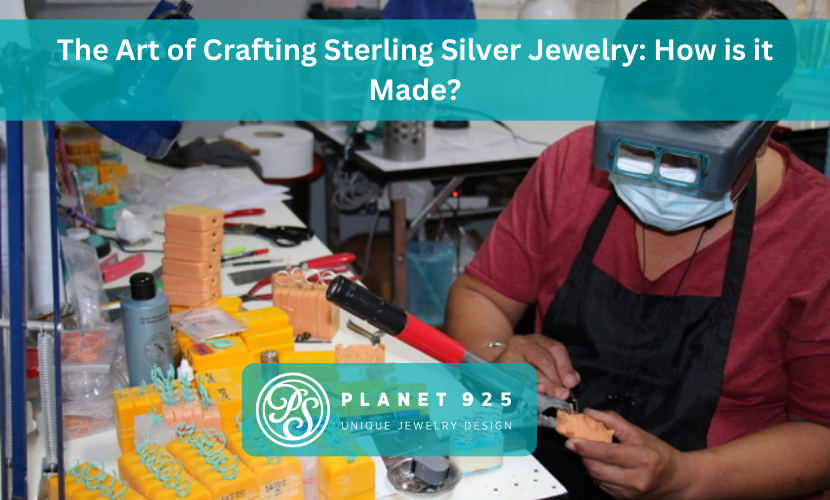

Table of Contents
Introduction
Sterling silver jewelry is admired worldwide for its elegance, versatility, and timeless appeal. Yet, few people realize the intricate process and skilled craftsmanship that goes into creating each piece. For retailers and jewelry enthusiasts, understanding this artistry is not only fascinating but also adds value when selecting quality pieces for customers.
At Planet Silver, we take pride in combining traditional methods with modern techniques to produce sterling silver jewelry that stands out in both beauty and durability. As a leading wholesale and manufacturing provider, we ensure each step in the crafting process is meticulously executed to maintain the highest standards. In this post, we’ll take you through the fascinating journey of how our sterling silver jewelry is made—from the first spark of design inspiration to the final polish.
1. Jewelry Design
Each piece of sterling silver jewelry begins with a blend of creativity and current market trends. At Planet Silver, our staff’s careful planning and research ensures each item showcases sterling silver’s beauty, resulting in high-quality, in-trend jewelry retailers can confidently offer their customers.
2. Master Creation
Once the design is finalized, a “master” model is created, serving as the prototype for all future pieces. This master is crafted with precision, typically from wax, and captures every detail of the design. Skilled artisans carefully shape this model to ensure it accurately reflects the intended look and quality.
The master is essential because it serves as the blueprint for producing identical pieces at scale. At Planet Silver, this step is handled meticulously, as the quality of the master directly impacts the consistency and excellence of each final jewelry piece.
3. Rubber Mold Creation
With the master model ready, the next step is to create a durable rubber mold by tightly sandwiching it with specialized rubber. Great care and preparation is taken to avoid any large gaps. The rubber and the master are placed inside a vulcanizer, where the rubber fuses together. This mold encases the master, capturing every detail before being carefully cut to allow for easy separation. The rubber mold enables us to replicate the design consistently, producing identical wax models for each piece.
4. Wax Tree Assembly
Once the rubber mold is complete, hot wax is injected into it to create wax replicas of the jewelry piece. These wax models are then carefully assembled onto a central structure called a “wax tree,” with multiple pieces attached to a single stem. This arrangement allows us to cast many pieces simultaneously, improving production efficiency.
5. Lost Wax Casting
The lost wax casting process is where the magic truly happens. Once the wax tree is assembled, it is encased in a special plaster material (called investment) to create a mold. The entire assembly is then heated, causing the wax to melt and flow out, leaving behind a hollow cavity that perfectly mirrors the original design.
Next, molten sterling silver alloy is poured into this cavity, filling the space left by the wax. As the silver cools and solidifies, it takes on the intricate details of the jewelry piece.
At Planet Silver, we carefully monitor this process to ensure each piece is cast with precision and quality. This technique not only allows for complex designs but also ensures the durability and integrity of the final product.
6. Pre-polishing and Assembly
After the lost wax casting process, the newly cast pieces are removed from their molds and undergo pre-polishing. This step involves carefully removing any rough edges, sprues, or imperfections that may have occurred during casting. Skilled artisans use various tools to smooth the surfaces, preparing the pieces for final finishing. Polishing consists of mainly placing the jewelry into a tumbler, where rotation, water and special rocks or stainless steel shots do most of the work.
If the design consists of multiple components, this is also the stage where assembly occurs. Our staff meticulously fits together any parts, ensuring each piece aligns perfectly and meets our quality standards.
7. Final Polishing
Once the pre-polishing and assembly are complete, the jewelry pieces move on to the final polishing stage. This crucial step enhances the shine and overall appearance of the sterling silver, giving each piece its signature luster.
At Planet Silver, we utilize a combination of polishing compounds and specialized tools to achieve a flawless finish. The final step is a thorough polish on the buffer wheel and ultrasonic clean to remove all polishing compounds revealing a mirror-like surface.
This meticulous process not only highlights the intricate details of the design but also ensures a smooth surface that feels comfortable against the skin. The result is stunning jewelry that captivates customers with its radiant shine, ready to be presented to retailers and consumers alike.
8. Quality Control
All jewelry is tested to ensure it meets our quality assurance standards. We look for scratches, sharp edges, dents, missing parts or stones, wrong colors, or misaligned components. We verify weight, legible 925 stamps, and stone quality.
Conclusion
The journey of crafting sterling silver jewelry is a meticulous process that involves artistry, skill, and precision at every stage. From the initial design and master creation to the final polish, each step plays a vital role in ensuring that the finished pieces meet the highest standards of quality and beauty. At Planet Silver, we are dedicated to preserving this craftsmanship, allowing retailers to offer stunning, high-quality jewelry that stands out in the marketplace.
Understanding the intricacies of this process not only enhances appreciation for sterling silver jewelry but also empowers retailers to communicate its value to customers. By choosing Planet Silver, retailers can trust they are sourcing expertly crafted pieces that embody both elegance and durability, making them a perfect addition to any jewelry collection. For more information about the kinds of machinery we use during this process, follow this link.


